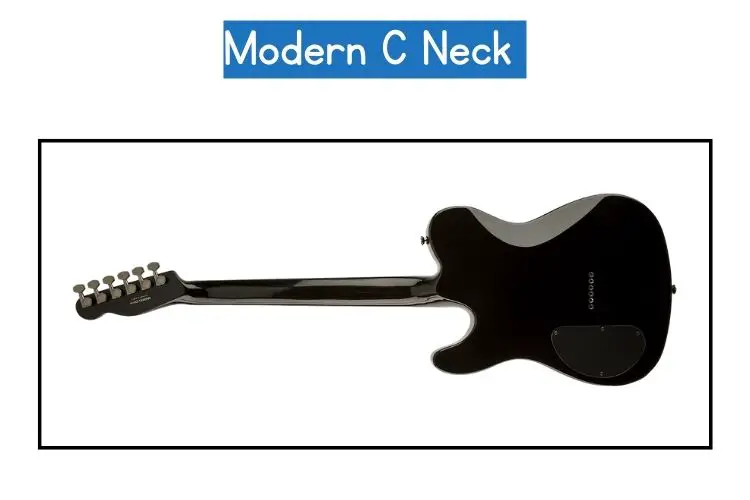The truth is, the size and shape of the guitar neck will always be an important consideration when buying a new guitar. It plays quite an important role in the overall feel and playability of the guitar.
A lot of new players make the mistake of buying the first guitar that they find visually attractive, or they go with a guitar that they have seen someone else playing.
While that product may sound amazing and look very nice, it needs to be ergonomic and comfortable, so you actually enjoy playing it for long hours.
This is particularly important when you are just starting out because if it is not comfortable, it will become that much harder to overcome that initial learning curve so you can get to the point where you will continue playing.
In terms of ergonomics, the neck shape is the most important consideration. Overall, you have the option of going for a C, U or V shape neck.
The most popular and most common shape is the C-shape. This is the most comfortable shape, and it works with all kinds of hand sizes.
Within the C-shape, you can also get different sizes (radius length). This is why we will always recommend that you physically try a guitar before buying it, so you get a feel for it. In this article, we will discuss the C-shape in depth to understand whether this is the right neck shape for you.
Table of Contents
Which Part Of The Guitar Is The Neck?
The neck is where the fretboard is on the guitar. This is where you place your fretting hand to play the different notes while you strum the other end of the guitar (the belly) with your strumming hand.
Below is a picture to help you understand what exactly the neck is
The shape of the guitar neck can be better understood through a cross-section picture of the neck.
The above cross section image clearly illustrates the way each neck shape differs and how they all sit differently in your hand.
The only thing you need to keep in mind is that each guitar neck shape can come in different sizes. Naturally, larger radiuses are better suited to larger hands/longer fingers.
The C-shape neck is the most rounded of the shapes, which is why it is so comfortable and easy-to-use for the vast majority of players.
Different Shapes Of Guitar Necks
Each shape has something unique to offer and what works for someone else may not work for you. Let’s look at each neck shape in more detail.
C-Shape
This shape is the most popular due to its comfort and ease of playability. For most guitar players and most hand shapes, this shape is going to be the best shape to go for. The C-shape is also the thinnest of the shapes, so it’s very easy to play with speed on this kind of neck.
However, since it is so thin, it is also prone to warping and more wear and tear than other shapes. The C-shape neck is also available in varieties. These include extra thin, fat, and huge.
Depending on your hand shape and size, a modified version of the standard C-shape may suit you better.
U-Shape
The U-shape is very similar to the C-shape neck, but it has bolder and more pronounced shoulders. This gives it a heftier and more solid feel in the hand.
Various players also refer to this shape as the ‘baseball bat’ shape, as its increased girth makes it feel a bit like the striking end of a baseball bat in your hand.
This is a great shape for players with larger hands or those that prefer to rest their fingers on the bigger shoulders. This is a very sturdy shape, due to the increased thickness, but it can also be quite uncomfortable for players with smaller palms or shorter fingers.
In fact, some players may not even be able to reach certain notes on the fretboard due to the broader radius.
V-Shape
The V-shape is available in two main formats, namely, the soft and hard shape. The hard version of this shape has a more pronounced peak, which makes it rest better between your index finger and thumb.
The soft V shape has a more rounded peak, which allows the neck to rest slightly lower in your hand and doesn’t bite into your palm as much.
This is a classic shape commonly found on vintage guitars from the 1930s-1970s. Today, this is a niche design that is preferred by players who tend to hang their thumbs on the fretboard.
If you prefer to hang your thumb off the fretboard, then a hard V-shape will be a good choice. Otherwise, if you are just looking for a snug fit, then a soft V will also work well.
C-Shape Vs. U-Shape Necks
C-Shape
C-shape necks with their soft shoulders, rounded base and small radius are perfect for small hands and large hands alike. This makes this shape suitable for a lot of different styles and makes overall playability that much easier.
It is an excellent choice for beginners and advanced players alike. If you prefer this shape but have larger hands, you can also get a larger version of the C-shape that has the same flat shoulders but a slightly thicker neck.
U-Shape
To make the shoulders more robust, the U-shape guitars need to have a thicker neck and a broader radius. While this is very helpful for players with larger hands, it can be a little problematic for players used to the C-shape or those that prefer a thinner neck.
However, this is a very durable design and you can also get it in smaller sizes, but it will still be significantly larger than the standard C-shape.
Pros And Cons Of C-Shape Neck
Choosing a guitar neck shape boils down to personal preferences. To find the best match for your style and size of hand, we always recommend that you try out a few different shapes to see what works best for you. However, there are a few pros and cons to the C shape that you should consider.
Pros
- A flexible shape that will work well for the average hand size
- It’s easy to play for any style of music
- The thinner neck means it is much lighter. Something you will notice on guitars that have necks made of dense wood.
- The shallow neck profile also usually means shallow frets which add to the comfort
- A lot of guitar brands, and guitar models, come with this shape of neck so you can easily find a guitar of your choice with this kind of neck.
Cons
- It is not as sturdy as other neck shapes and is the most prone to warping
- Players with bigger hands can feel like the fretboard is too ‘crowded’
- C-shapes come in a lot of varieties and the standard C-shape can also vary from one manufacturer to the other. It’s best you try out the C-shape before buying.
15 Modern Electric Guitars With C-Shape necks
If you are in the market for an electric guitar with a C-shape neck, these models may be of interest to you.
- Squier 40th Anniversary Gold Edition Telecaster
- Schecter Reaper-6
- Fender Player Stratocaster
- Fender Player Telecaster HH—Incredible Tele
- Schecter Sun Valley Super Shredder FR-S
- Schecter Solo-II Blackjack
- D’Angelico Excel EXL-1 Hollowbody Electric Guitar
- Fender American Performer Telecaster
- Fender American Performer Stratocaster HSS
- Fender American Professional II Stratocaster
- Squier Contemporary Stratocaster Special HT
- Epiphone Coronet Ebony
- Squier Classic Vibe ’50s Stratocaster
- Harley Benton Fusion-T HH
- Yamaha Pacifica 012
15 Modern Acoustic Guitars With C-Shape necks
- Harley Benton D-120CE TB
- Fender FA-15 3/4
- Gretsch G9500 Jim Dandy Flat Top
- Guild A-20 Bob Marley
- Fender Redondo Player Acoustic
- D’Angelico Premier Bowery
- Guild D-140
- Fender Acoustasonic Player Telecaster
- Cordoba GK Pro Negra
- Breedlove Oregon Concert CE
- Fender American Acoustasonic Stratocaster
- Guild F-55 Jumbo Acoustic
- Guild OM-140CE Orchestra
- Cordoba C5-CET Limited
- D’Angelico Excel Gramercy X
Who Should Get A C-Shape Neck?
If you are a beginner, if you have small hands, if you want a guitar that will be flexible enough for any kind of music, or if you are seeking a do-it-all solution, then a C-shape neck will be a good choice.
This is an excellent starting point and once you get familiar with the C-shape, It becomes quite easy to adapt to other neck shapes. That being said, you will be in a better position to choose your next guitar neck shape.
For some people, just a different size within the C-shape is the best solution. Even if you have larger hands, a C-shape is still recommended. Of course, you can get a larger version of this shape to compensate for size requirements, but overall, this is a great shape for playability.
Conclusion
The neck of the guitar can make or break the deal. If you are looking to explore new guitar neck shapes, then consider C-shape to be the standard and compare other shapes according to the C-shape.
If you have already tried it and are looking for something new, then both the U and V shapes are good options to explore. Also remember to try different sizes in each shape to see what works best for your hand size and your playing style.
The same shape can feel very different on acoustic and electric guitars, so it’s best to try out the exact guitar you are interested in before making your final decision.



![HERE’S What Happened to the Soul Singer Al Green [2023 Update]](https://performerlife.com/wp-content/uploads/2023/04/what-happened-to-al-green-211x150.jpg)
